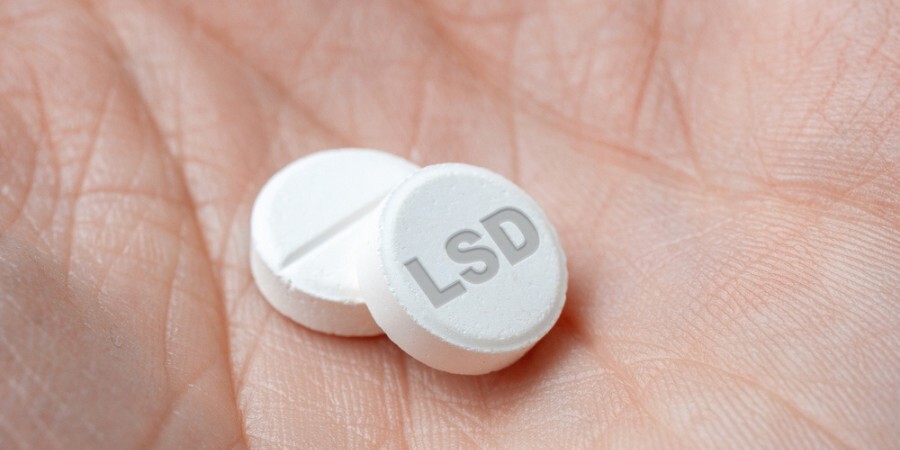Last Updated:
July 31st, 2025
LSD Addiction | Symptoms, Effects and Causes
What is LSD?
LSD (Lysergic Acid Diethylamide) is a powerful hallucinogenic drug that alters a person’s perception of reality, mood and cognitive processes. It’s commonly referred to as “acid” and is often found in forms like blotter paper, tablets or liquid drops placed on sugar cubes. The drug is known for inducing intense hallucinations, where users might see vivid colours, distorted objects or even entirely new realities.
People use LSD for its mind-altering effects, often seeking creative inspiration or an escape from reality. Some describe experiencing heightened emotions, an altered sense of time or feeling more connected to the world. However, these effects are highly unpredictable.
In the UK, LSD is classified as a Class A drug, meaning its production, distribution, and possession are illegal. Penalties for breaking these laws can include hefty fines and lengthy prison sentences.
Is frequent usage of LSD dangerous?
Frequent LSD use can be dangerous due to its unpredictable and often intense effects. Each trip can vary significantly, even when using the same dose. This unpredictability increases the risk of experiencing negative or frightening hallucinations, which can cause panic or irrational behaviour. During a “bad trip,” users might lose touch with reality, putting themselves at risk of physical harm.
Another major concern is Hallucinogen Persisting Perception Disorder (HPPD), commonly known as flashbacks. People with HPPD may experience recurring visual distortions or hallucinations long after the drug’s effects have faded. This can interfere with daily life, making even simple tasks challenging.
Is LSD addictive?
LSD is not considered physically addictive like substances such as cocaine or heroin. This means users typically don’t experience withdrawal symptoms when they stop using it. However, it can still cause psychological dependence. This type of addiction happens when someone becomes mentally reliant on the effects of the drug, craving the escape or heightened experiences it provides.
One key factor contributing to this dependency is the rapid development of tolerance. After using LSD multiple times, the body quickly becomes less sensitive to the drug’s effects. Users may take increasingly larger doses in an attempt to replicate previous experiences. This can be dangerous, as high doses can lead to intense and potentially traumatic hallucinations.
The emotional crash that follows an LSD trip, known as a comedown, can also fuel dependency. After experiencing euphoria and intense emotions, returning to everyday life can feel dull or depressing. In an attempt to avoid these negative feelings, some users might turn back to LSD repeatedly, creating a destructive cycle.
While physical overdose from LSD is rare, dangerous side effects such as dehydration, exhaustion, and reckless behaviour can occur, especially during extended or repeated trips.
Struggling with an addiction? If you are ready to seek help, reach out to us today, and a member of our compassionate team will help you find the best option for starting your recovery journey.
What are the signs of an LSD addiction?
Recognising the signs of LSD addiction is crucial for both users and their loved ones. Early intervention can make a significant difference in recovery. The quicker the signs and symptoms of LSD addiction are understood, the quicker a problem can be identified and treated effectively.
Here are some key signs to watch for:
Physical signs
- Dilated pupils: A classic indicator of LSD use that can persist after a trip.
- Unusual sweating: Often linked to heightened body temperature during trips.
- Sleep problems: Persistent insomnia or disrupted sleep patterns caused by frequent use.
- Tremors or muscle twitches: Involuntary shaking or muscle spasms can occur, especially during or after intense trips, reflecting the drug’s impact on the nervous system.
Psychological signs:
- Mood swings: The user may find themselves shifting between extreme highs and emotional crashes.
- Paranoia or anxiety: Especially after repeated trips or intense experiences.
- Preoccupation with LSD: Constantly thinking about the next trip or planning when to use again.
- Flashbacks: Users could experience flashbacks of previous trips, which can occur at any given moment. This can be frightening and confusing, leading to negative outcomes.
Behavioural signs:
- Neglecting responsibilities: Missing work, school or family obligations due to LSD use or recovery from trips.
- Social withdrawal: Avoiding family and friends to hide usage or avoid judgment.
- Risky behaviour: Engaging in unsafe activities while under the influence, without considering consequences.
- Obsessive focus on the drug: Constantly thinking about, seeking, or talking about LSD, including romanticising past experiences.
If these signs persist, it could be a clear indicator that professional help is needed. In the next section, we focus on how to determine whether or not an LSD addiction is present
Do I have an LSD addiction?
While we don’t condone any form of drug usage, If you’re using LSD, it’s essential to stay mindful of how often you use the drug and how it affects your life. Addiction doesn’t always develop overnight and can creep up quietly, only becoming obvious when serious problems arise.
Below, we invite you to be honest and answer the five questions that we have produced. Answering ‘yes’ to any of them may indicate a growing dependence on LSD:
- Do you find yourself thinking about using LSD even when you didn’t plan to?
- Have you missed important life events or obligations because of LSD use?
- Do you experience distressing hallucinations or flashbacks after using LSD?
- Have you developed a tolerance, needing more LSD to achieve the same effect?
- Do you feel unable to stop using LSD, even when it causes problems in your life?
If these questions resonate with you, reaching out for professional help could be the first step toward recovery. In the next section, we take a closer look at how LSD addiction can be treated.
How is an LSD addiction treated?
Treating LSD addiction requires a comprehensive approach that addresses both the psychological and emotional aspects of the disorder. Because LSD affects the mind deeply, treatment focuses on mental health support, helping individuals understand why they became dependent and how to manage their lives moving forward.
When it comes to LSD rehab, it can usually be taken in two settings; inpatient LSD rehab and outpatient LSD rehab. To determine which one is best for your circumstances, an initial assessment is usually taken by a healthcare provider.
Treatment at a rehab centre typically includes:
- Structured routine: Establishing a daily schedule promotes stability and purpose, helping reduce relapse risk.
- Therapeutic support: Therapies such as cognitive-behavioural therapy (CBT), dialectical behaviour therapy (DBT), and one-on-one counselling help individuals process their experiences and develop coping strategies.
- Group therapy: Connecting with others facing similar challenges can reduce feelings of isolation and build a supportive community.
- Holistic treatments: Practices like yoga, meditation, art therapy and mindfulness exercises encourage emotional healing and self-expression.
The goal of treatment is to equip individuals with tools for long-term recovery, enabling them to navigate life’s challenges without relying on LSD or other substances.
Reach out for help
If you or someone you care about is struggling with LSD addiction, professional support can make a lasting difference. Reach out to a rehab centre today and take the first step toward a healthier, more fulfilling life free from addiction.
Our compassionate team are ready and available to take your call, and guide you towards lasting the lasting addiction recovery you deserve.
Frequently Asked Questions
(Click here to see works cited)
- Müller F, Kraus E, Holze F, Becker A, Ley L, Schmid Y, Vizeli P, Liechti ME, Borgwardt S. Flashback phenomena after administration of LSD and psilocybin in controlled studies with healthy participants. Psychopharmacology (Berl). 2022 Jun;239(6):1933-1943. doi: 10.1007/s00213-022-06066-z. Epub 2022 Jan 25. PMID: 35076721; PMCID: PMC9166883.



